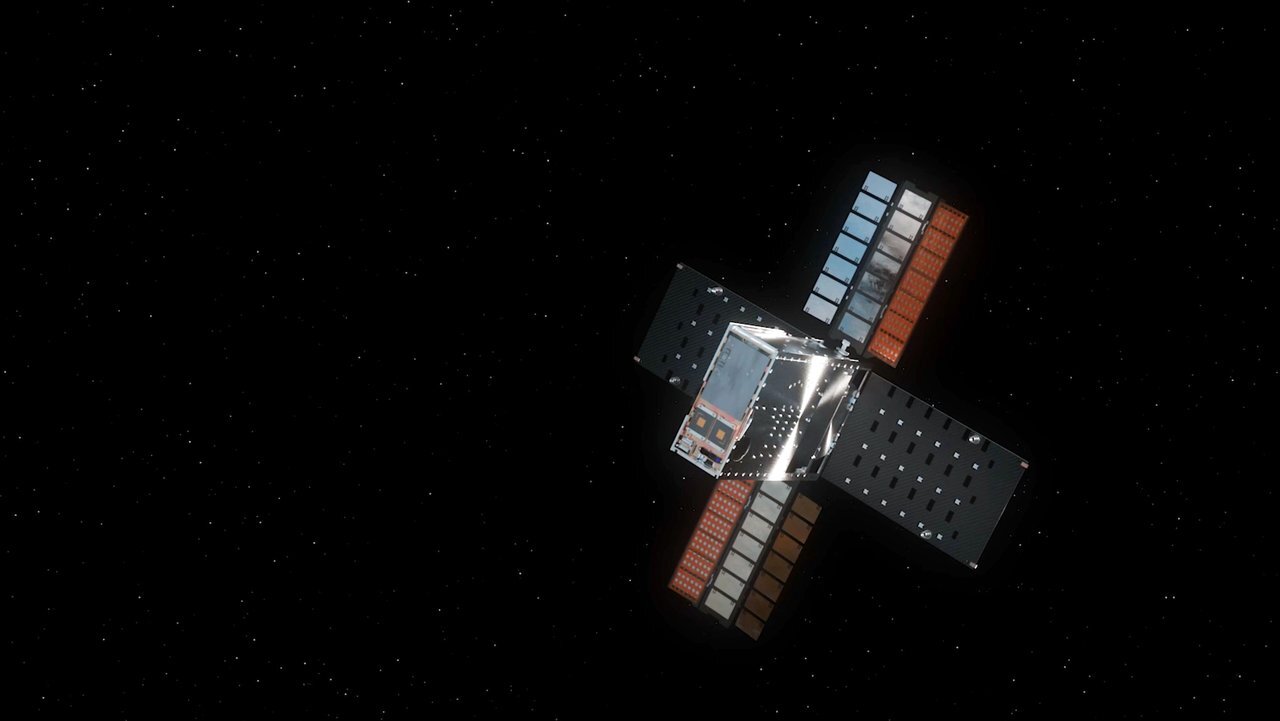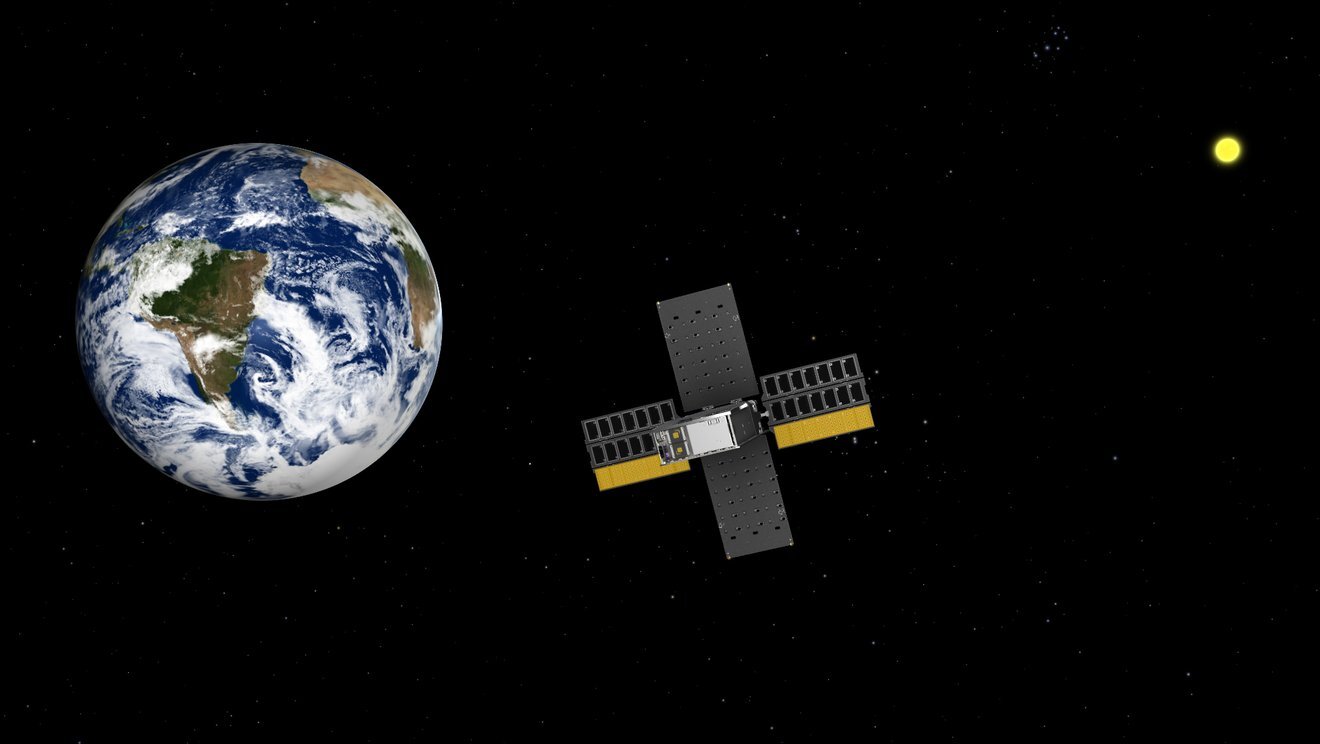12.12.2022
NASA’s Lunar Flashlight Has Launched – Follow the Mission in Real Time

This illustration shows NASA’s Lunar Flashlight, with its four solar arrays deployed, shortly after launch. The small satellite, or SmallSat, will take about three months to reach its science orbit to seek out surface water ice in the darkest craters of the Moon’s South Pole.
Credit: NASA/JPL-Caltech
NASA’s Eyes on the Solar System web-based visualization tool lets you “see” the SmallSat as it journeys to the Moon and seeks out water ice in the darkest craters there.
NASA’s Lunar Flashlight has communicated with mission controllers and confirmed it is healthy after launching Sunday, Dec. 11, at 2:38 a.m. EST (Saturday, Dec. 10, at 11:38 p.m. PST) from Cape Canaveral Space Force Station in Florida. About 53 minutes after launch, the small satellite, or SmallSat, was released from its dispenser to begin a four-month journey to the Moon to seek out surface water ice in permanently shadowed craters at the lunar South Pole.
“It was a beautiful launch,” said John Baker, the Lunar Flashlight project manager at NASA’s Jet Propulsion Laboratory in Southern California. “The whole team is excited to see this small spacecraft do some big science in a few months’ time.”
While Lunar Flashlight will never return to Earth, the world hasn’t missed its last chance to see the briefcase-size spacecraft. Rendered in crisp detail, a 3D digital version of the solar-powered SmallSat has made its debut in NASA’s Eyes on the Solar System, the agency’s recently revamped visualization tool.
A 3D model of NASA’s Lunar Flashlight can be viewed in the fully interactive Eyes on the Solar System, including its journey to the Moon and when it reaches orbit to search for surface water ice at the lunar South Pole. Zoom out and use the fast-forward and rewind controls to follow the SmallSat.
“As soon as the Lunar Flashlight mission reached space, Eyes began tracking it, just as it will throughout the SmallSat’s entire science mission,” said Jason Craig, visualization producer at JPL. “The system uses real trajectory data from the mission, so as Lunar Flashlight’s journey unfolds, you can see exactly where the SmallSat is.”
The spacecraft’s avatar is an exact model of the real thing, down to its four solar arrays, science instrument, and thrusters. With the drag of a finger or mouse, users can change their perspective of the SmallSat and see where it is in space, whether on its long trek to lunar orbit or when it’s zooming above the lunar surface, collecting science data.
To get close to the Moon’s surface, the SmallSat will employ what’s called a near-rectilinear halo orbit – designed for energy efficiency – that will take it within just 9 miles (15 kilometers) over the lunar South Pole and 43,000 miles (70,000 kilometers) away at its farthest point. Only one other spacecraft has employed this type of orbit: NASA’s Cislunar Autonomous Positioning System Technology Operations and Navigation Experiment (CAPSTONE) mission, which launched earlier this year and can also be viewed in NASA Eyes, including as it makes its closest passes over the lunar North Pole.
Lunar Ice Science
Lunar Flashlight will use a reflectometer equipped with four lasers that emit near-infrared light in wavelengths readily absorbed by surface water ice. This is the first time that multiple colored lasers will be used to seek out ice inside these dark regions on the Moon, which haven’t seen sunlight in billions of years. Should the lasers hit bare rock or regolith (broken rock and dust), the light will reflect back to the spacecraft. But if the target absorbs the light, that would indicate the presence of water ice. The greater the absorption, the more ice there may be.
The science data collected by the mission will be compared with observations made by other lunar missions to help reveal the distribution of surface water ice on the Moon for potential use by future astronauts.
Lunar Flashlight will use a new kind of “green” propellant that is safer to transport and store than the commonly used in-space propellants such as hydrazine. In fact, the SmallSat will be the first interplanetary spacecraft to use this propellant, and one of the mission’s primary goals is to demonstrate this technology for future use. The propellant was successfully tested on a previous NASA technology demonstration mission in Earth orbit.
More About the Mission
Lunar Flashlight launched on a SpaceX Falcon 9 rocket as a rideshare with ispace’s HAKUTO-R Mission 1. Lunar Flashlight is managed for NASA by JPL, a division of Caltech in Pasadena, California. Barbara Cohen, the mission’s principal investigator, is based at NASA’s Goddard Space Flight Center in Greenbelt, Maryland. Lunar Flashlight will be operated by Georgia Tech, including graduate and undergraduate students. The Lunar Flashlight science team is distributed across multiple institutions, including Goddard, the University of California, Los Angeles, Johns Hopkins University Applied Physics Laboratory, and the University of Colorado.
The SmallSat’s propulsion system was developed by NASA’s Marshall Space Flight Center in Huntsville, Alabama, with development and integration support from Georgia Tech. NASA’s Small Business Innovation Research program funded component development from small businesses including Plasma Processes Inc. (Rubicon) for thruster development, Flight Works for pump development, and Beehive Industries (formerly Volunteer Aerospace) for specific 3D printed components. The Air Force Research Laboratory also contributed financially to the development of the Lunar Flashlight propulsion system. Lunar Flashlight is funded by the Small Spacecraft Technology program within NASA’s Space Technology Mission Directorate.
Quelle: NASA
----
Update: 18.05.2023
.
NASA’s Lunar Flashlight to Fly by Earth

This screenshot from NASA’s Eyes on the Solar System 3D visualization tool shows Lunar Flashlight making its close approach with Earth late on May 16. The CubeSat will pass about 40,000 miles (65,000 kilometers) from our planet’s surface over Brazil’s east coast.
Credit: NASA/JPL-Caltech
With its primary mission over, the CubeSat will zoom by Earth late Tuesday, May 16, and NASA’s Eyes on the Solar System app will track it, providing a chance to say farewell.
NASA’s Lunar Flashlight mission to the Moon has ended, but the briefcase-size spacecraft will soon fly past Earth before heading into deep space. On Tuesday, May 16, at 9:44 p.m. PDT (Wednesday, May 17, at 12:44 a.m. EDT), the CubeSat will pass about 40,000 miles (65,000 kilometers) from our planet’s surface.
NASA’s Eyes on the Solar System 3D visualization tool will track the tiny spacecraft in real time, giving users a front-row seat to the flyby. (The tool also provides plenty of information about the spacecraft, including its orbit and forthcoming deep space voyage, as well.) In addition, the CubeSat may be within reach of amateur astronomers’ telescopes in the Southern Hemisphere.
“As Lunar Flashlight zooms by, it may reflect enough sunlight from its solar panels that it could be seen through a modest telescope,” said Barbara Cohen, Lunar Flashlight principal investigator at NASA’s Goddard Space Flight Center in Greenbelt, Maryland. “Depending on its orientation and position it could be up to a magnitude 5 or 6 moving dot.”
While still tens of thousands of miles away, the sunlight bouncing off the CubeSat’s solar panels may be visible for those with clear, dark skies. The brightness of an astronomical object can be measured as apparent magnitude. As an object of magnitude 5 or 6, the CubeSat may be visible to backyard telescopes when it passes at its closest point over the east coast of Brazil. Observers should use NASA Horizons to check where in the sky Lunar Flashlight will be.
After launch on Dec. 11, Lunar Flashlight was sent on a long, looping path, far beyond Earth orbit. Now it has returned to the proximity of our planet, after being pulled back by the combined gravity of Earth and the Moon.
The spacecraft was designed to test new technologies and address knowledge gaps by exploring permanently shadowed craters on the Moon’s South Pole. But soon after Lunar Flashlight launched, its operations team discovered that the CubeSat’s four thrusters were underperforming. After months of troubleshootingto remedy the situation, time ran out for the spacecraft to make critical maneuvers that would have put it in orbit around Earth with monthly flybys of the Moon’s South Pole. When it became clear that Lunar Flashlight couldn’t get into the required orbit for lunar observations, NASA called an end to the rest of its mission. The spacecraft’s other systems are functioning well and it remains in contact with mission operators. NASA is now weighing options for Lunar Flashlight’s future.
After passing Earth, the CubeSat will continue into an orbit around the Sun. Lunar Flashlight’s orbit will bring it close to Earth once more in November 2037.
More About the Mission
Lunar Flashlight is managed for NASA by the agency’s Jet Propulsion Laboratory, a division of Caltech in Pasadena, California. The CubeSat is operated by Georgia Tech, including graduate and undergraduate students. The Lunar Flashlight science team is led by NASA Goddard Space Flight Center in Greenbelt, Maryland, and includes team members from multiple institutions, including the University of California, Los Angeles; Johns Hopkins University Applied Physics Laboratory; and the University of Colorado.
The CubeSat’s propulsion system was developed by NASA’s Marshall Space Flight Center in Huntsville, Alabama, with development and integration support from Georgia Tech. NASA’s Small Business Innovation Research program funded component development from small businesses including Plasma Processes Inc. (Rubicon) for thruster development, Flight Works for pump development, and Beehive Industries (formerly Volunteer Aerospace) for specific 3D-printed components. The Air Force Research Laboratory also contributed financially to the development of Lunar Flashlight’s propulsion system. Lunar Flashlight is funded by the Small Spacecraft Technology program based at NASA’s Ames Research Center in Silicon Valley and within NASA’s Space Technology Mission Directorate.
Quelle: NASA
